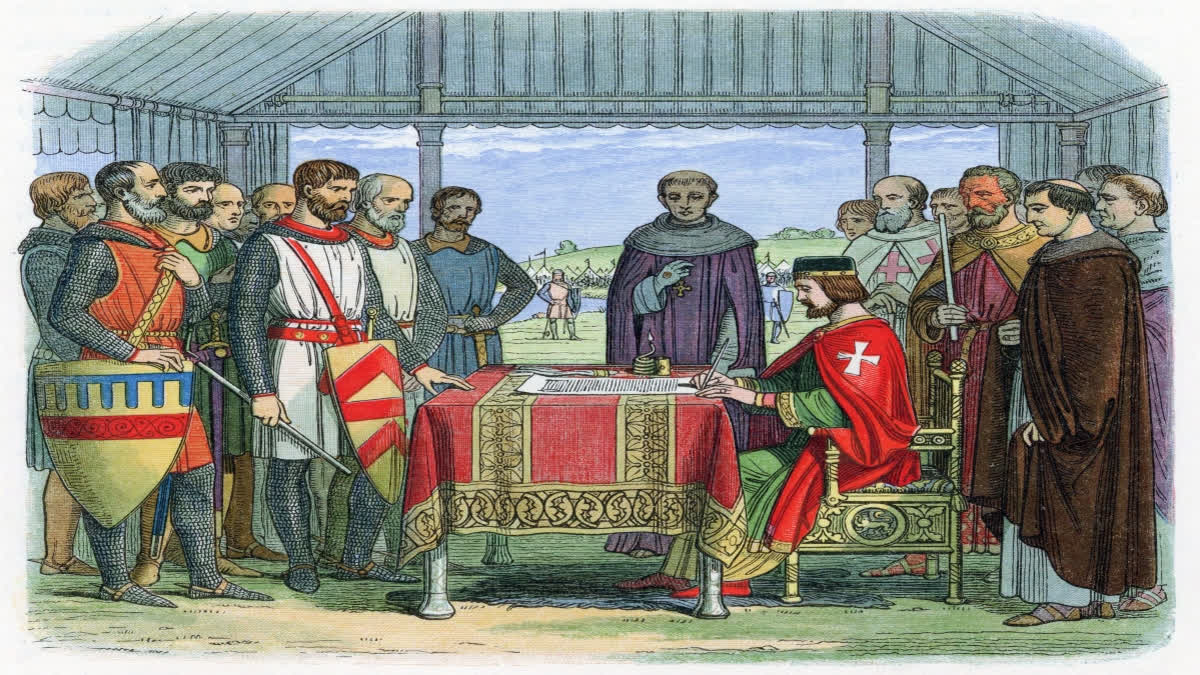Hyderabad: Magna Carta Day is celebrated on June 15 every year. This day remembers the ratification of the Great Charter, which limited the power of the English monarch.
Magna Carta is Latin for 'great charter'. The term was first used in 1217 to distinguish it from the Charter of the Forest, a document that also set out limits on the king's administration. The Charter set out what the king could and could not do. In other words, Magna Carta set out the laws which the king and everyone else had to follow for the first time.
The Magna Carta is a basic document that states liberties guaranteed to the English people. It proclaims rights that have become a part of English law and are now the foundation of the constitution of every English-speaking country. This document has been used as the template for civil liberties not just in the United Kingdom but all over the world, highlighting parliamentarianism, constitutionalism, and liberty.
History: The Magna Carta was drawn up by English barons (nobles) and church leaders to limit the king’s power. In 1215 they forced the tyrannical King John to agree to the charter. King John’s cruelty and greed united the powerful feudal nobles, the church leaders, and the people against him.
He demanded too much money in taxes. While the king was waging a disastrous war in France, the leading barons of England met secretly and swore to compel him to respect the rights of his subjects. When John returned, they presented him with a series of demands.
John tried to gather support in order to avoid giving in to the demands, but almost all his followers deserted him. So at the end, he met with them along the south bank of the Thames River, in a meadow called Runnymede. King John affixed his seal to the Magna Carta on June 15, 1215.
Significance: The Magna Carta sought to prevent the king from exploiting his power, and placed limits of the royal authority by establishing law as a power in itself. This great charter acknowledged the firmly embedded concept that no man -- not even the king -- is above the law.
The Magna Carta was a pivotal document in the shift towards democratic governance, establishing legal rights and influencing modern justice systems. In 1948 the United Nations (UN) adopted the Universal Declaration of Human Rights, the foundational document of international human rights law. It was referred to as humanity's Magna Carta by Eleanor Roosevelt, who chaired the UN Commission on Human Rights, responsible for the drafting of the document.
Facts about 'Magna Carta':
- There is no single original copy of the Magna Carta. Multiple copies exist of this document of approximately 3600 words
- In 2007, one copy of the Magna Carta from 1297 sold at auction for $21.3 million. This was the most ever paid for a single page of writing
- Historians know who signed the Magna Carta, but no one is exactly sure who was responsible for actually writing it. It was more likely to have been written by the Archbishop of Canterbury at the time
- The document had 63 sections. It deals with feudal rights and duties and also includes provisions that protect the rights of the church, merchants, and townspeople
- The Magna Carta stated that the king must follow the law and could not simply rule as he wished. It was one of the first documents to state that citizens had such rights. Today many people consider the Magna Carta to be the first written constitution in Europe
- The Magna Carta also guaranteed the rights of women and children who inherited property, and it stated that people could not be punished for crimes unless they were lawfully convicted
- The Magna Carta gave barons the right to declare war on the king if he did not follow the charter's provisions
- The Magna Carta is considered a forerunner of the English Bill of Rights, the U.S. Declaration of Independence, and the French Declaration of the Rights of Man and of the Citizen. In the United States, both the national constitution and the state constitutions show ideas and even phrases directly traceable to the Magna Carta
- There are four extant original copies of the Magna Carta of 1215. Two of them are held by the cathedral churches in which they were originally deposited— Lincoln and Salisbury — and the other two are in the British Library in London. The four "originals" were assembled in one place for the first time in February 2015 as part of a British Library commemoration of the 800th anniversary of the charter’s issue.
How to Participate in Magna Carta Day: On this day, everyone is encouraged to visit libraries and attend festivals. You can learn more about the Magna Carta by visiting The Magna Carta Project or visit one of the four remaining copies. You can also encourage people to learn more about the rich history behind people’s rights in Great Britain.



